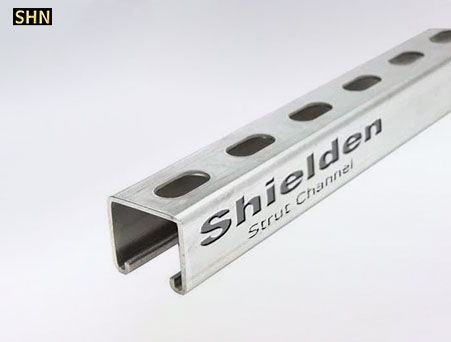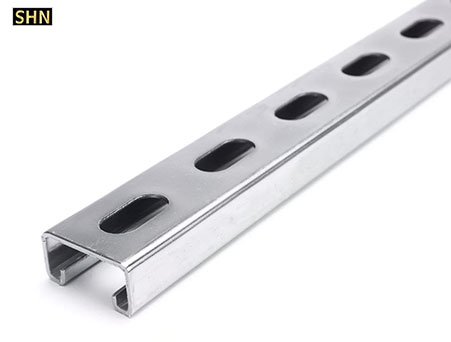+86 10 5248 4022
+86 18518927929

Mar. 12, 2024
Channel strut, often referred to as "strut channel" or "construction strut," is a versatile and indispensable component in various industries, providing robust support and mounting solutions for a wide array of applications. From construction projects to electrical installations, channel strut plays a vital role in ensuring stability, durability, and efficiency.

Channel strut is a metal framing system consisting of a continuous slotted channel, typically made of steel or aluminum. It features a series of holes or slots along its length, allowing for easy attachment of fittings, accessories, and fixtures. This design flexibility makes channel strut an ideal choice for supporting conduits, pipes, cables, and equipment in diverse settings.
Channel strut functions by providing a sturdy framework for securing and organizing various components within a structure. Its modular design enables quick and simple assembly, adjustment, and reconfiguration, facilitating efficient installation and maintenance processes.
Channel strut offers unparalleled versatility and reliability, making it indispensable in numerous industries such as construction, electrical, mechanical, and telecommunications. Its ability to support heavy loads, withstand harsh environmental conditions, and adapt to different mounting requirements makes it a preferred choice for professionals seeking robust support solutions.

Channel strut serves as a foundational element in construction projects, providing structural support for a wide range of components and systems. Its applications include:
Supporting electrical conduits:
Channel strut serves as a conduit support system, securely holding electrical conduits in place and preventing sagging or displacement. This ensures the safe and efficient routing of wires and cables throughout a building.
Mounting HVAC equipment:
Channel strut provides a stable platform for mounting heating, ventilation, and air conditioning (HVAC) equipment such as ductwork, air handlers, and condenser units. By securely attaching HVAC components to channel strut, contractors can optimize airflow, maximize energy efficiency, and streamline installation processes.
Securing plumbing fixtures:
Channel strut is used in plumbing installations to support and secure various fixtures, including pipes, valves, and fixtures. Its robust construction and adjustable design allow for precise positioning and alignment, ensuring leak-free connections and optimal plumbing performance.
What benefits does channel strut offer compared to other support systems?
Channel strut boasts several key advantages that set it apart from traditional support systems:
Versatility in mounting options:
Channel strut accommodates a wide range of fittings, brackets, and accessories, enabling users to customize mounting solutions to suit specific project requirements. Whether it's suspending overhead cables, securing equipment to walls, or creating multi-tiered support structures, channel strut offers unmatched versatility and adaptability.
Durability and strength:
Constructed from high-quality materials such as galvanized steel or aluminum, channel strut exhibits exceptional durability and load-bearing capacity. Its robust design withstands heavy loads, impacts, and environmental factors, ensuring long-lasting performance in demanding applications.
Adaptability to various environments:
Channel strut is suitable for use in diverse environments, including indoor and outdoor settings, commercial and industrial facilities, and corrosive or hazardous conditions. Its corrosion-resistant coatings and rugged construction make it ideal for harsh environments where moisture, chemicals, or extreme temperatures may be present.
What are the different variations of channel strut available in the market?
Channel strut is available in several configurations, each designed to meet specific application requirements:
Standard channel struts:
Standard channel struts feature a continuous, unperforated channel with evenly spaced mounting holes along its length. This basic design provides a solid foundation for various support applications and allows for easy attachment of accessories.
Slotted channel struts:
Slotted channel struts feature elongated slots along the length of the channel, offering greater flexibility in positioning and adjusting attachments. This design allows for precise alignment of fittings and facilitates quick installation and reconfiguration.
Back-to-back channel struts:
Back-to-back channel struts consist of two parallel channels joined together back-to-back, providing increased load-bearing capacity and stability. This configuration is commonly used in heavy-duty applications where additional strength and support are required.
What criteria should you keep in mind when selecting channel strut for your project?
When choosing channel strut for your project, several factors should be considered to ensure optimal performance and compatibility:
Load capacity requirements:
Evaluate the anticipated loads and weight distribution to determine the appropriate channel strut size and configuration. Consider factors such as equipment weight, dynamic loads, and environmental conditions to select a strut system capable of supporting the intended load safely and securely.
Corrosion resistance:
Assess the environmental conditions and exposure to corrosive agents such as moisture, chemicals, or salt spray. Choose channel strut materials and finishes with adequate corrosion resistance to withstand the specific challenges of your application, ensuring long-term durability and reliability.
Installation flexibility:
Consider the ease of installation and compatibility with existing infrastructure when selecting channel strut components. Look for features such as pre-punched holes, adjustable fittings, and tool-less assembly options to streamline installation processes and minimize downtime.
How can you properly install channel strut for maximum effectiveness?
Proper installation of channel strut is essential to ensure optimal performance and safety. Follow these guidelines for successful installation:
Preparing the mounting surface:
Begin by inspecting the mounting surface to ensure it is clean, level, and free of any obstructions. Use appropriate fasteners and anchors to secure the channel strut to walls, ceilings, or floors, taking care to distribute the load evenly and avoid overloading.
Attaching channel strut accessories:
Once the channel strut is securely mounted, attach the necessary accessories and fittings using compatible hardware. Ensure that all connections are tight and properly aligned to prevent movement or slippage during use.
Securing the load safely:
After installing the channel strut and accessories, carefully position and secure the load according to the manufacturer's recommendations. Use appropriate hardware such as clamps, brackets, or hangers to support the load evenly and minimize stress on the strut system.
How can you ensure the longevity and performance of channel strut systems?
Regular maintenance is key to maximizing the lifespan and efficiency of channel strut systems. Follow these maintenance tips to keep your strut system in optimal condition:
Regular inspections for signs of wear:
Periodically inspect channel strut components for signs of corrosion, deformation, or damage. Pay close attention to areas where fittings, accessories, or loads are attached, as these areas may be prone to wear and fatigue over time.
Cleaning and lubricating moving parts:
Clean channel strut components regularly to remove dirt, debris, and contaminants that could impair performance or cause premature wear. Use a mild detergent and water solution to clean the surfaces, and apply a lubricant to moving parts such as sliding fittings or adjustable brackets to reduce friction and prevent binding.
Prompt repairs for damaged components:
Address any damage or wear issues promptly to prevent further deterioration and ensure the safety and stability of the channel strut system. Replace damaged components as needed, and reinforce connections or supports if signs of weakness or instability are detected.
Can channel strut be used outdoors?
Yes, channel strut is suitable for use in outdoor environments,
provided that it is constructed from materials and finishes with adequate corrosion resistance. Stainless steel or hot-dip galvanized channel strut is commonly used for outdoor applications where exposure to moisture, UV radiation, or harsh weather conditions is a concern.
What load capacities are available for channel strut?
Channel strut systems are available in a range of load capacities to accommodate various application requirements. Standard channel struts typically have load capacities ranging from light-duty (e.g., 50 lbs. per foot) to heavy-duty (e.g., 1,000 lbs. per foot) loads, with options for custom configurations and reinforcements available for specialized applications.
Are there any alternatives to channel strut for support applications?
While channel strut is a popular choice for support applications due to its versatility and reliability, several alternatives may be considered depending on specific project requirements. These alternatives include threaded rod systems, wire rope suspensions, and custom-designed support structures, each offering unique advantages and considerations in terms of load capacity, installation complexity, and cost-effectiveness.
Leave Message
Write down your urgent needs to get free samples, and to check our stocks

Copyright © SS&HN INDUSTRY GROUP Ltd. All Rights Reserved | Sitemap | Powered by 